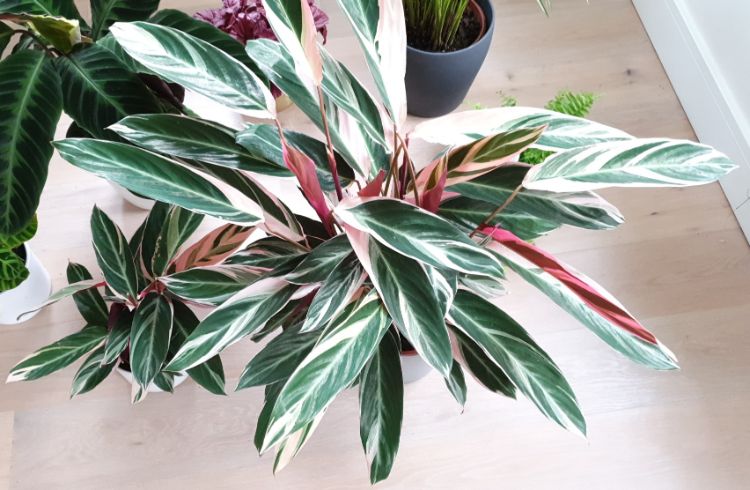The Stromanthe Triostar is one of those sensational, star-quality plants you fall in love with immediately. Its artistically splashed green-and-white foliage glows with pinkish hues that demand attention—and boy, does it. This is not a beginner’s plant. Stromanthe triostar care can be filled with joy and heartbreak, but the effort is so worthwhile.
Stromanthe Triostar care summary: Plant your triostar in well draining potting mix, place in medium, filtered light and water with purified water to maintain moist but not soggy soil. Provide high humidity of at least 50%, temperatures of 65°F (18°C) to 80°F (27°C) and fertilize every 2-3 weeks with 1/4 to 1/2 strength, balanced fertilizer.
Still with us? If you’re determined to give stromanthe triostar care a try, this article will show you how. We can’t promise it will be easy … but the best plants in life seldom are.
Overview Of Stromanthe Triostar Care
Stromanthe Triostar is a Calathea relative that needs the humid conditions and highly filtered light of a rainforest understory to look its best. Before discussing the terms of your peonage to its captivating foliage, let’s discuss what they have to offer.
The long, broad leaves are a glossy, variegated canvas colored with vibrant green and creamy white irregular splotches that glow with pink hues from their reddish undersides. They can bear spring flowers, but their contrasting foliage is the main feature.
A relative of the Prayer Plant (Maranta), Triostars move according to their light source and its intensity. The plant constantly rearranges its leaves throughout the day as if conducting a slow concert of color.
The Christmassy colors make Triostar a unique holiday alternative to Poinsettas. They make good gifts for green thumbs, but it might not be the best offering to those with less experience. Without the right care, the plants are likely to decline in sync with New Year’s resolutions.
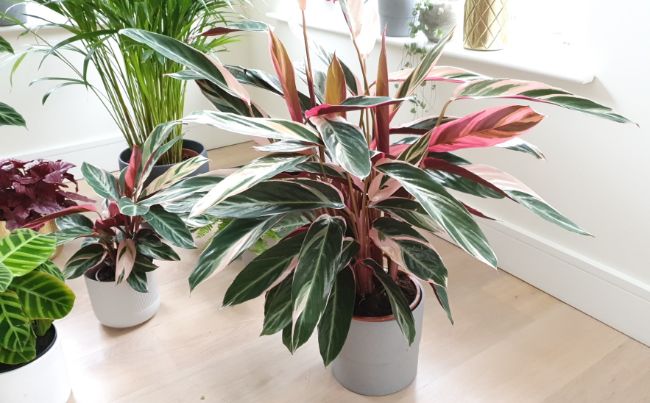
Stromanthe Triostar Characteristics
Stromanthe Triostar is a rhizomatous tropical perennial. It can be grown in shady spots outdoors in USDA zones 9-11, and its stunning foliage also makes it a popular houseplant.
The plant’s short stems support leaves that are six to twelve inches long. There’s an enormous variety of leaf variegation: No two plants—or even two leaves—are exactly the same. The leaves fold up at night; this apparently helped them conserve precious raindrops back home.
The Triostar likes medium illumination and burns easily in direct sunlight. It commonly reaches two or three feet high and wide. It’s typically smaller indoors. It does well in normal household temperatures and has limited cold tolerance.
This Stromanthe can produce white or pink blooms within orange, tube-shaped bracts in winter and early spring. They don’t often flower as houseplants … it’s a colorful but undependable bonus.
Why Stromanthe Triostar Is Not A Beginner’s Plant
It isn’t so difficult to keep a Triostar alive, it’s just hard to keep them pristine. Triostars can throw an ugly tantrum if they don’t get their way.
Without proper treatment, the lovely white variegation turn a sickly yellow and brown, and the edges can crisp. These aren’t a good look for the plant. The situation can be reversed, but Stromanthes grow rather slowly out of their warm season … mistakes aren’t quickly forgiven.
If you live in a South American rainforest or a humid locale like Florida, this plant might be considered easy … some people grow five foot high specimens by just keeping them watered. (These people usually tell you about it, too.)
Stromanthe Triostar Care Requirements
- Scientific Name: Stromanthe sanguinea ‘Triostar’
- Common Name: Stromanthe Triostar, Calathea Triostar, variegated bloody stromanthe
- Origin: Brazil
- Light Requirements: Medium, indirect light
- Watering: Maintain moist but not soggy soil. Use filtered, distilled or rainwater ideally.
- Soil: Well draining potting mix. Equal parts potting mix and perlite works well.
- Temperature: 65-80°F (18-27°C)
- Fertilizer: Every 2-3 weeks while actively growing with very dilute, balanced fertilizer. Flush the soil several times per year.
- Humidity: Needs high humidity to keep foliage looking well.
- Pruning: Prune dead leaves and to maintain size and shape.
- Propagation: Propagate by division in late spring/early summer.
- Re-Potting: Triostars don’t like to be repotted too often. Prefer being root bound.
- Diseases and Pests: High humidity can encourage fungal disease, but generally quite resistant. Some plant suckers such as aphids are sometimes seen.
- Toxicity: Non-toxic to humans and animals.
- Where To Buy: Buy Stromanthe Triostar online at Etsy (I buy most of my houseplants from Etsy).
Stromanthe Triostar Light Conditions
Triostars have an interesting way of interacting with sunlight. Medium filtered light is the go-to situation: the plant doesn’t tolerate direct sun and burns easily.
Their best spot is usually near an east-facing window with mild morning sun, placed no more four feet from the window. A bright northern exposure is another good choice.
Stromanthes’ odd behavior with light which can be confusing to its owners. Most variegated plants lose their color in dim conditions, so it seems logical to place the plant in bright light—but the Triostar is different and may respond poorly.
To understand their needs we must consider how they live in nature. Heavy tree foliage deflects the hot, intense sun that beats down on the upper stories of a rainforest, making light quite precious on the ground where they live—but that same sun can sear tender leaves with dappled rays that break through. The Triostar copes by moving around.
The leaves’ red-shaded undersides conserve light by absorbing rays at higher rates; this accounts for their surreal pinkish glow. The leaves fold up in the low light of dusk and nighttime, and open and turn their reflective white-streaked side to the sun each morning. The photoactive leaves move quickly (for a plant) to follow the light throughout the day, showing either their reflective surface or protective undercoat as their light changes.
These adaptations are why the Triostar holds its variegation in lower light better than many species. They also make the plant a little tricky to predict. The best advice is to observe the plant’s health and be prepared to adjust its conditions accordingly.
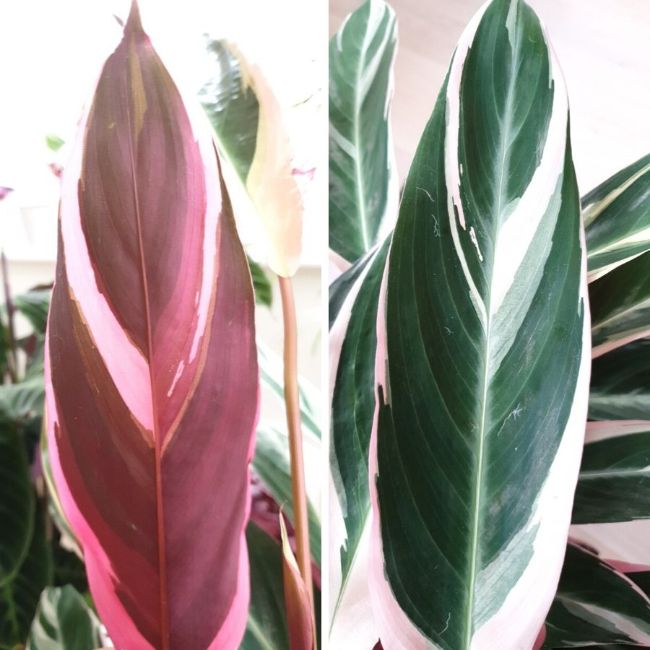
Watering Is Critical To Stromanthe Triostar Care
The plant can adjust to different lighting, but they are a bit high maintenance in their water requirements. It’s where you can really go wrong. Consistency is important: they like their soil slightly moist, never too dry or soggy.
You’ll have to pay attention, since their ever-moving leaves don’t give you helpful “fainting” signs when they need water. If you need a little help working out when to water your plants, read my guide to assessing your plants’ watering needs.
Let the top inch of soil get dry before rewatering, but don’t push it. One good method is to learn how much water they need to last a week before being ready for a refill. This requires some attention to get right but helps with consistency.
Keep them a bit drier during the cool season.
The other important factor is water quality. Even dechlorinated tap water contains impurities that can turn their leaf edges brown. You might get by with filtered water, but for best results use rainwater, distilled water, or water prepared by reverse osmosis. It should ideally be room temperature, too.
Stromanthe Triostar Humidity Needs
Humidity is another critical element in your Triostar’s well-being, but it’s not complicated. The plant originates in Brazil and shows no inclination to assimilate: you must bring the rainforest home.
The usual methods of grouping plants and pebble-filled water trays may be enough if the ambient humidity isn’t too low, but if you see browning leaves you’ll need something more. You may have luck with frequent misting with pure, room-temperature water.
A room humidifier is a more industrial solution. If your home is extremely dry, the upkeep of a humidifier might be the cost of success with Triostars.
I’ve written a helpful article which explains the best ways to increase humidity without having to walk round misting them all day.
Soil Requirements
Stromanthe Triostar likes light, well-draining soil that breathes and holds moisture without becoming soggy. One way to get the right mix is to combine a peaty houseplant potting soil with enough perlite to make it fluffy. An organic medium is excellent as long as it drains well.
The Triostar’s tuberous rhizomes do fine in a shallow planter or bowl. If you have a large, full specimen, a deeper planter may help keep the soil more consistently moist. Don’t go too big or you’ll encourage stagnant lower regions.
Finally, drainage holes are very important. Don’t put a layer of pebbles on the bottom—this only allows extra moisture to be trapped beneath the roots.
Pro Tip: To keep the light soil from falling out, you can cut a small piece of a coffee filter, wet it, and place it over the pot’s drainage hole(s).
Stromanthe Triostar Temperature Requirements
This one’s easy: Normal home temperatures are fine. Indoors, the main concern is to keep them out of drafts.
Triostars like the warmer side of the range with nighttime temps that don’t fall below 60°F (15°C). 65°F (18°C) to 80°F (27°C) is ideal. This is reportedly one of the more cold-hardy Calatheas, but bring them inside well ahead of frost.
How To Fertilize Stromanthe Triostar
The Triostar benefits from regular feeding during the warm season. A balanced formula without excess nitrogen is best. A balanced water soluble fertilizer is a good option. Organic fertilizers like worm castings are also excellent.
One recommended method is to dilute the fertilizer to a quarter-strength and feed every two weeks when watering. This helps ensure the sensitive roots aren’t burned. Organic fertilizers are even safer and don’t need such dilution.
Consider supplementing bi-monthly with a quarter-dilution of chelated iron with micronutrients.
Rare Flowering
Triostars can produce flowers in March and April. The tubular blossoms emerge above the foliage in loose clusters. They open as orange-red buds and mature into a cherry pink.
Though the flowers aren’t particularly sensational, they add a highlight. Triostars don’t often bloom indoors, so don’t feel bad if you never see them.
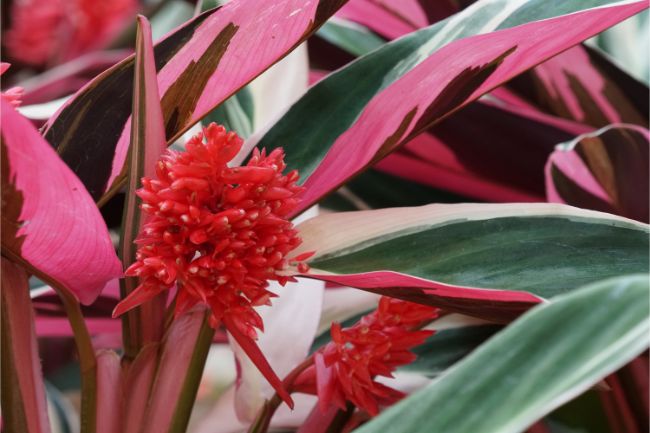
How To Prune Stromanthe Triostar
The only necessary pruning is to trim away damaged leaves. Cut the stem at the base with sterilized shears.
Removing damaged leaves is normal maintenance that doesn’t bother them at all. You can expect a few leaves of even thriving plants to randomly dry up or decline.
Pruning affects the light reaching the rest of the plant, so avoid removing more than a third of the foliage at once.
Propagating Stromanthe Triostar
A simple separation and replanting of the rhizome clumps is the standard propagation method. It’s best done in early spring before the growing season kicks in.
Be gentle with the Triostar’s roots. They are delicate, and damage will be reflected in their leaves.
Here are the steps:
- Prepare a new planter using the recommended soil. Use a pot just large enough for their root ball.
- Carefully remove the mother plant from its pot. Ideally it will come out in one piece. If you have trouble, water the soil before gradually working the roots out of the pot. Wetting the soil helps keep the roots from breaking.
- Gently locate the rhizomes and tease their roots apart. Each rhizome will have a separate set of roots.
- Cover each rhizome with potting mix at the level of the original planting. Water and set it in the original plant’s light.
Careful Re-Potting
Repotting tends to be a big deal for Triostars. Hold off until the plant has outgrown its old pot. The best time is in the late spring or summer. It’s usually not a good idea to repot a plant you’ve just brought home.
Pro Tip: Double-pot the nursery container to avoid disrupting the plant’s roots as it acclimates to a new environment.
Their small root systems do well in shallow pots. Go up just one pot size from their existing container … their rhizomes aren’t extensive and empty soil space can complicate watering.
Use the recommended porous soil, and take your time. Their tiny roots are easy to damage. If you’re upgrading the medium, gently remove the loose soil that doesn’t have live roots.
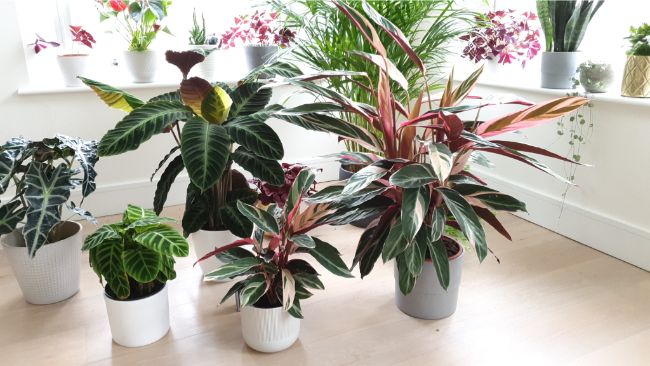
Stromanthe Triostar Care and Planting Tips
- Don’t repot when you first get this plant. Let it adjust first.
- Triostars seem to respond well to daily misting.
- It’s a good idea to flush the soil at the end of each season to rinse away salt and chemical buildup. Wait until its time to water, and sprinkle the topsoil until a stream runs from the drainage holes (don’t use tap water). Tilt the pot to make sure there isn’t any pooled water remaining.
- If you love the plant, give it a try. Some individual Triostars seem okay with less than ideal humidity or other factors. I don’t understand it either.
Varieties
Triostar is a patented cultivar that has a few close copies. Each has different variegation but shares their maroon-colored undersides.
The Stromanthe sanguinea has been changed to Stromanthe thalia, but much of the trade still uses the older name. Also, it’s often misnamed a Tricolor plant.
At least one older variety exists with much less variegation. Its leaves are almost completely green, though the leaves’ undersides remain reddish. There’s also a Stripestar, which sports a single white or pale green streak down the center of each leaf.
The variety most often mistaken for Triostar is called the Magicstar, or Stromanthe valmic. It was introduced in 2007. It has less variegation, and the leaves stand a bit higher. These are often sold as Triostars, so double-check. The green of the Magicstar leaf contains white speckling, while the Triostars’s green areas are solid.
One newer variation that highlights the commercial reality of new “discoveries” is the Rotolante10. Patented in 2015, it has thin white stripes that radiate from the leaf’s center instead of showing irregular splotches like the genuine Triostar. Perhaps this cultivar will be hitting Instagram soon.
Diseases And Pests
Stromanthes aren’t overly prone to disease, but their high demand for moisture does create ideal conditions for fungus, molds, etc. You can stay ahead of these issues by letting the top of the soil dry out slightly between waterings.
Pro Tip: Cinnamon is a natural fungus preventative.
Triostars aren’t particularly vulnerable to pests, either—their main issues are common plant-suckers. Aphids are their biggest pest, but they’re easily handled with a mild horticultural soap or neem oil spray. If humidity is very low, spider mites could show up; though, in that case you’ll probably have other problems to worry about.
Common Stromanthe Triostar Care Questions
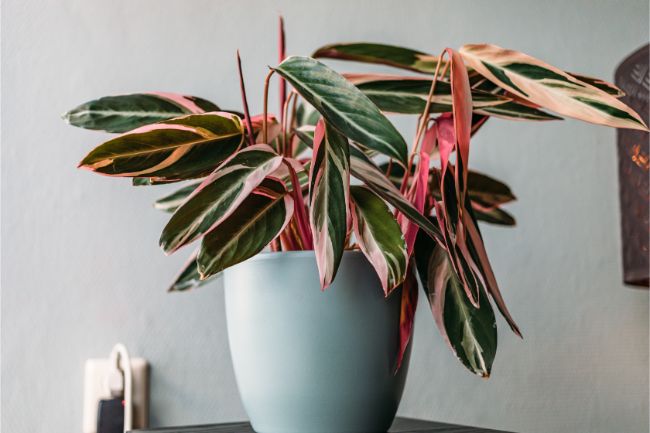
Are Triostars Toxic?
Stromanthes are non-toxic and safe for people and pets.
Why Is My Triostar Not Growing After Repotting?
It’s likely regrowing its roots and won’t show much top growth until its done. It’s a good sign if the plant isn’t visibly declining.
Why Is My Triostar Turning Brown Despite good Watering And Humidity?
Spotting can be caused by misting if the water droplets are too large and don’t evaporate quickly. It can also happen if the water contains impurities.
Another cause could be dry spots in the soil that repel water. To check, gently probe the soil after a watering. Break up and soak any areas you find.
Why Is My Triostar Turning Yellow?
The typical cause is overwatering, but odd discoloration on Triostar leaves is usually related to their roots. The soil could have excess chemicals and salts left over from fertilizers. Try flushing with purified water. Don’t disturb the roots until the color improves.
Is Stromanthe A Calathea?
Stromanthe are a genus of plants within the family marantaceae. Calathea are also within the marantaceae family but are a separate genus. Stromanthe and calathea are closely related and share many traits and can look quite similar to each other. Marantaceae are often commonly known as the prayer plant family due to the characteristic of many plants in this family to fold up their leaves at night, as if in prayer.

